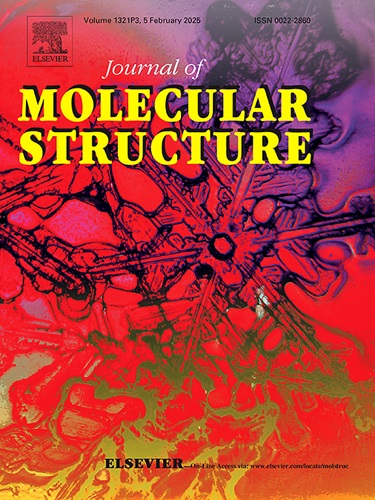Design, synthesis, in vitro, and in silico investigations of new barbituric acid-hydrazone-chalcone derivatives as promising urease inhibitors
IF 4
2区 化学
Q2 CHEMISTRY, PHYSICAL
引用次数: 0
Abstract
The present study focuses on the synthesis of a library of arylated hydrazones of barbituric acid, aiming to develop exceptionally potent urease inhibitors. A two-step synthesis was adopted; first, chalcone derivatives were synthesized by reacting 4-aminoacetophenone with variously substituted aldehydes under basic conditions, these derivatives were then treated with barbituric acid to afford barbituric acid hybrids 5a-n. The FTIR, CHNS, 1H NMR, and 13C NMR were structurally characterized. All compounds were examined for their potential against the urease enzyme and displayed remarkable results with IC50 values ranging from 4.84 ± 0.62 to 13.36 ± 0.23 µM. The structure-activity relationship was also established, revealing that compound 5n (IC50 = 4.84 ± 0.62 µM) with -Cl and -NO2 substitutions para to each other plays a major role in urease inhibition and is identified as the most potent analog of the library. Moreover, molecular docking investigations indicated the barbituric acid rings in all compounds align consistently, with the carbonyl group at C2 positioned toward the bi-nickel center atoms, resembling the orientation in AHA and thiourea. Chalcone and hydrazone subunits occupy a similar conformation near the active site's entrance. Compound 5n is stabilized at the active site's bi-nickel center by the barbiturate moiety, which forms metal coordination bonds and hydrogen bonds with key residues like Asp633, His492, and Cys592. Additional interactions with His593, Arg439, and His594 contribute to its stability and influence the flexibility of the active site's mobile flap, ultimately inhibiting urease activity.

新型巴比妥酸-腙-查尔酮衍生物脲酶抑制剂的设计、合成、体外和硅片研究
本研究的重点是巴比妥酸芳基化腙库的合成,旨在开发特别有效的脲酶抑制剂。采用两步法合成;首先,在碱性条件下,由4-氨基苯乙酮与不同取代醛反应合成查尔酮衍生物,然后用巴比妥酸处理得到巴比妥酸杂化物5a-n。对FTIR、CHNS、1H NMR和13C NMR进行了结构表征。所有化合物的IC50值均在4.84±0.62 ~ 13.36±0.23µM之间。结果表明,-Cl和-NO2相互取代的化合物5n (IC50 = 4.84±0.62µM)在脲酶抑制中起主要作用,是该文库中最有效的类似物。此外,分子对接研究表明,所有化合物中的巴比妥酸环排列一致,C2上的羰基指向双镍中心原子,类似于AHA和硫脲中的取向。查尔酮和腙亚基在活性位点入口附近具有相似的构象。化合物5n被巴比妥酸酯部分稳定在活性位点的双镍中心,与关键残基如Asp633、His492和Cys592形成金属配位键和氢键。与His593、Arg439和His594的其他相互作用有助于其稳定性,并影响活性位点移动瓣的灵活性,最终抑制脲酶活性。
本文章由计算机程序翻译,如有差异,请以英文原文为准。
求助全文
约1分钟内获得全文
求助全文
来源期刊

Journal of Molecular Structure
化学-物理化学
CiteScore
7.10
自引率
15.80%
发文量
2384
审稿时长
45 days
期刊介绍:
The Journal of Molecular Structure is dedicated to the publication of full-length articles and review papers, providing important new structural information on all types of chemical species including:
• Stable and unstable molecules in all types of environments (vapour, molecular beam, liquid, solution, liquid crystal, solid state, matrix-isolated, surface-absorbed etc.)
• Chemical intermediates
• Molecules in excited states
• Biological molecules
• Polymers.
The methods used may include any combination of spectroscopic and non-spectroscopic techniques, for example:
• Infrared spectroscopy (mid, far, near)
• Raman spectroscopy and non-linear Raman methods (CARS, etc.)
• Electronic absorption spectroscopy
• Optical rotatory dispersion and circular dichroism
• Fluorescence and phosphorescence techniques
• Electron spectroscopies (PES, XPS), EXAFS, etc.
• Microwave spectroscopy
• Electron diffraction
• NMR and ESR spectroscopies
• Mössbauer spectroscopy
• X-ray crystallography
• Charge Density Analyses
• Computational Studies (supplementing experimental methods)
We encourage publications combining theoretical and experimental approaches. The structural insights gained by the studies should be correlated with the properties, activity and/ or reactivity of the molecule under investigation and the relevance of this molecule and its implications should be discussed.
 求助内容:
求助内容: 应助结果提醒方式:
应助结果提醒方式:


